- Books Name
- ACME SMART COACHING Biology Book
- Publication
- ACME SMART PUBLICATION
- Course
- CBSE Class 11
- Subject
- Biology
BRYOPHYTA
Bryophyta is a small group of plants having multicellular diploid sporophyte living as a parasite on an independent multicellular haploid gametophyte.
On the basis of evolution, bryophytes stand in between algae and pteridophyta. They are the first amphibians of plant kingdom, oldest bryophyte fossils are about 350 million years old.
General characters of Bryophyta :
Bryophytes live in damp, humid and shaded habitats. They may form green carpets or mats on damp soil, rocks, walls, tree trunks during rainy season.
The dominant phase or plant body is a free living gametophyte (n). It is thallus like and may be prostrate or erect.
Vascular tissues are absent.
True stem, leaf and roots are absent. Instead, rhizoids occur for attachment. The latter may be unicellular (e.g., Riccia and Anthoceros) or multicellular (e.g., mosses).
Vegetative reproduction is quite common through fragmentation, tubers, gemmae, buds, adventitious branches etc.
Asexual reproduction by mitospores is absent.
Sex organs are multicellular and jacketed, called antheridium (male) and archegonium (female). The jacket cells are sterile (Bryophytes are first archegoniates).
Antherozoid is twisted and comma shaped with two flagella.
An external layer of water is essential for the swimming of male gametes to reach the archegonia i.e., zooidogamy. So these are called amphibians of plant kingdom.
Zygotes do not undergo reduction division immediately. It develops inside archegonia and divides by mitosis to produce embryo (so these are considered as first embryophytes). The embryo develops further into a sporophyte which is parasitic over the gametophyte (may be partial pasasite as in mosses).
The sporophyte of bryophytes is also called sporogonium, it is composed of three parts viz., capsule, seta and foot. It produces meiospores or haploid spores inside the capsule part (after meiosis in spore mother cells), while attached to the gametophyte.
All bryophytes produce only one type of spores (Homosporous).
On germination each spore produces a gametophyte (either directly or through a juvenile filamentous stage called protonema, e.g., in mosses).
Bryophytes show heteromorphic or heterologous alternation of generations in the life cycle i.e., haplodiplontic life cycle.
Concept Builder
Term bryophyta was proposed by Brown. Hedwig is called father of bryology. Prof. Shiv Ram Kashyap is known as "Father of Indian Bryology".
Aquatic bryophytes are Riccia fluitans, Ricciocarpus, Fontinalis and Riella. Saprophytic bryophytes are Buxbaumia and Cryptothallus, while Frullania is an epiphytic form.
Economic importance of bryophytes
(i) Prevention of soil erosion: Bryophytes, especially mosses, form dense mats over the soil and prevent soil erosion against falling rains.
(ii) Soil formation: Mosses are an important link in plant succession on rocky areas. They take part in building soil in rock crevices formed by lichens. Growth of Sphagnum (Bog moss) ultimately fills ponds and lakes with soil.
(iii) Water retention : Dry Sphagnum has great water absorbing capacity. This characteristic is employed by gardeners to keep seedlings and cut plants moist during transportation and propagation. Sphagnum moss was used in place of absorbent cotton, so is also called cotton moss.
(iv) Peat: Sphagnum often grows in acidic marshes. The older dead parts of moss and other marshy plants got slowly carbonised, compressed and fossilised over thousands of years and have produced a dark spongy mass called peat. Peat is dried, compressed and cut to form blocks. The peat blocks are used as fuel. Peat is also a good manure. It overcomes soil alkalinity and increases its water retention as well as aeration.
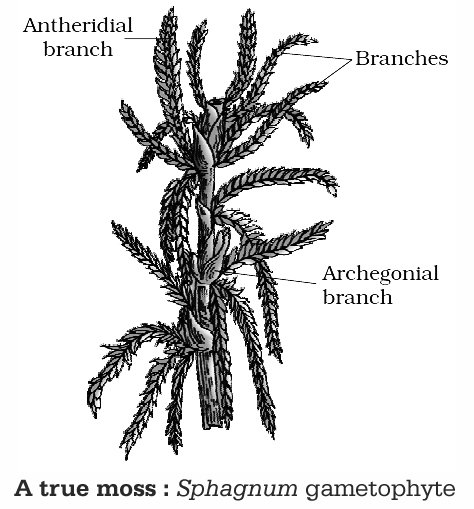
Classification of Bryophyta :

Some characteristic features of these classes are given below:
Hepaticopsida or Liverworts
They have thalloid structure (e.g., Riccia, Marchantia) with dorsiventral symmetry. On the ventral side of the thallus they have multicelled scales and unicelled rhizoids. Thallus has two distinct zones i.e., assimilatory and storage.
Leafy members like Porella have leaf like tiny appendages in two rows on the stem like structures.
Asexual reproduction occur by means of fragmentation, or by specialized structure called gemmae (e.g., Marchantia). These are '8' shaped, stalked, green and multicellular asexual buds developing in small receptacles (gemma cups) on dorsal surface of thallus. Each gemma germinates to produce two thalli in Marchantia.
Antheridia and archegonia are scattered and found embedded in dorsal side of thallus (e.g., Riccia) or may be projected from the thallus in form of stalked receptacles called antheridiophore and archegoniophore respectively (e.g., Marchantia).
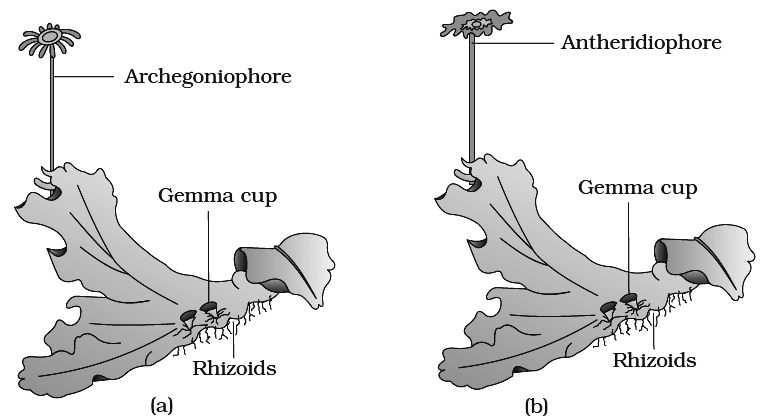
(a) Female thallus (b) Male thallus
Sporophyte may be represented by capsule only (e.g. , Riccia) or differentiated into foot, seta and capsule (e.g., Marchantia).
Capsule may contain spores only (e.g., Riccia) or spores and elaters (e.g., Marchantia). Elaters are diploid, hygroscopic structures with spiral thickenings which help in spore dispersal.
Sporophyte lacks assimilatory tissue, thus it is a complete parasite over the gametophyte.
Spores (n) germinate to form the thalloid gametophyte.
Concept Builder
Anthocerotopsida or Hornworts Anthoceros, Notothylas (Members of Anthocerotae) are called as hornworts, as they possess elongated 'horn like' sporophytes. Capsules of these members contain spores and pseudoelaters (elater like structures without spiral thicknings). Anthoceros cells have one chloroplast with one pyrenoid, so resembles algal thallus.
Bryopsida -Musci or True Mosses:
Gametophytic phase consist of two stages -first is protonema (juvenile stage) , and second is gametophore or leafy stage (mature).
Protonema is filamentous, creeping, green and branched structure developing through spore germination.
Gametophore consist of erect axis bearing spirally arranged leaves and sex organs.
Rhizoids are multicellular (with oblique septa) and branched.
Vegetative reproduction occurs by fragmentation and secondary protonema (filament developing from structure other than spore).
Sex organs develop in the axis of leaves.
The mosses have an elaborate mechanism of spore dispersal from capsule.
Mosses may be known by different names : Cord moss (Funaria), Maiden hair moss (Pogonatum), Peat/Bog moss (Sphagnum) , Hair cap moss (Polytrichum) .
Life cycle of Moss
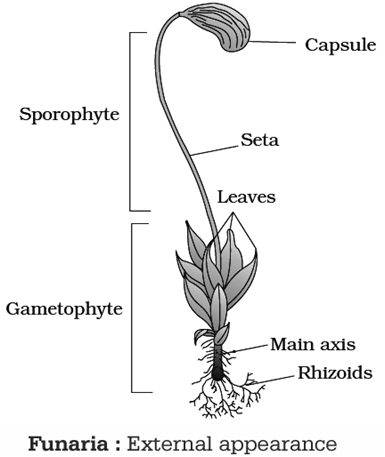
A typical moss plant like Funaria grows in moist, shady places forming dense carpet on soils, rocks, tree trunks etc., during the rainy season.
The radially symmetric plant body is differentiated into stem or axis, leaves or phylloids and rhizoids.
The rhizoids are multicellular. Moss plants multiply extensively by vegetative means.
Reproduction
1. Vegetative reproduction: It occurs by following ways:
(i) Apospory - Formation of gametophyte (i.e., the plant body) from sporophyte without meiosis.
(ii) Protonema buds - Primary protonema formed as a result of spore germination gives rise to group of cells called buds. These buds when separated give rise to new plants.
2. Sexual reproduction: Funaria is monoecious and autoecious plant i.e., male and female sex organs are borne on same plant, but on different branches, called as antheridial and archegonial branch respectively.
Antheridium :
Cluster of antheridia (male sex organ) are borne on antheridial branch, surrounded by a large number of closely arranged perigonial leaves.
An antheridium is a club-shaped structure. Paraphyses occurs mixed with antheridia. Terminal cell of paraphyses is capitate. It is borne over a small multicellular stalk.
There is a single layered jacket which encloses mass of sperm mother cells. Each sperm mother cell (androcyte) produces two biflagellate sperms having curved body.
Archegonium:
At the apex of archegonial branch, archegonia (female sex organ) intermingled with paraphyses are present, surrounded by a cluster of perichaetial leaves.
An archegonium is a flask-shaped structure having a multicellular stalk. It has a tubular neck and a swollen basal venter.
Venter has a two-layered wall which encloses two cells, a venter canal cell and an egg or oosphere. The neck has a single layered wall made of 6-spirally twisted rows of cells.
There is a cover made up of 4-cells. The neck encloses 6-10 Neck Canal Cells (NCC). At maturity, the neck canal and venter canal cells gelatinises. The lid cells separate.
The opened archegonia attract sperms by sucrose and K+ ions present in their mucilage. A sperm enters an archegonium, fuses with the oosphere and forms a diploid zygote or oospore
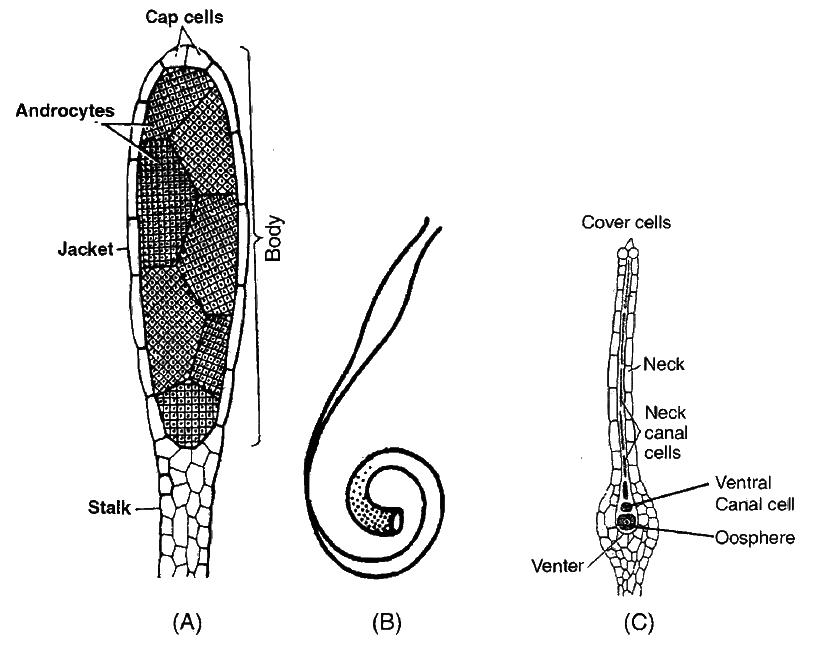
Development of sporophyte
The venter cells form a cover over zygote called calyptra (haploid -gametophytic tissue). The diploid oospore develops into a sporophyte. Sporophyte consists of three parts-foot, seta and capsule. Foot is embedded in the tip of gametophytic plant. It takes part in fixation of sporophyte and absorption of water and mineral salts from the gametophyte.
Seta is a narrow stalk which lifts the capsule in the air. The capsule is further differentiated into 3 parts-apophysis, theca and operculum. Apophysis contains assimilatory tissue and stomata (having a single circular guard cell).
Theca contains a central sterile column or columella, two spore sacs, air cavity and some assimilatory tissue. Its tip contain two rows of acellular teeth called peristome.
There are 32 peristomial teeth in each capsule arranged in two rows of 16 each. The teeth in outer row (exostome) are dark brown and hygroscopic in nature, and also have transverse bands of cellulose.
However teeth of inner row (endostome) are thin, light brown and non-hygroscopic. Inside the spore sac, diploid spore mother cells are formed.
They undergo meiosis and produce haploid spores.
The haploid spores are liberated from the capsule by removal of operculum and hygroscopic movement of peristomial teeth.
Since Funaria like mosses have some assimilatory tissue or cells with chloroplast in their sporophyte, unlike liver worts, sporophyte of mosses are often called as semiparasite over the gametophyte. Such cells are present in the apophysis, capsule wall and in the spores.
On germination, each haploid spore produces a filamentous juvenile gametophyte called protonema. Protonema has two types of branches, green and nongreen.
The nongreen branches (rhizonema) are subterranean. They function as rhizoids. Green branches (chloronema) are epiterranean.
Protonema can multiply vegetatively. It ultimately bears buds on its green branches. The buds grow to form moss plants. The latter, therefore, represent adult gametophyte.
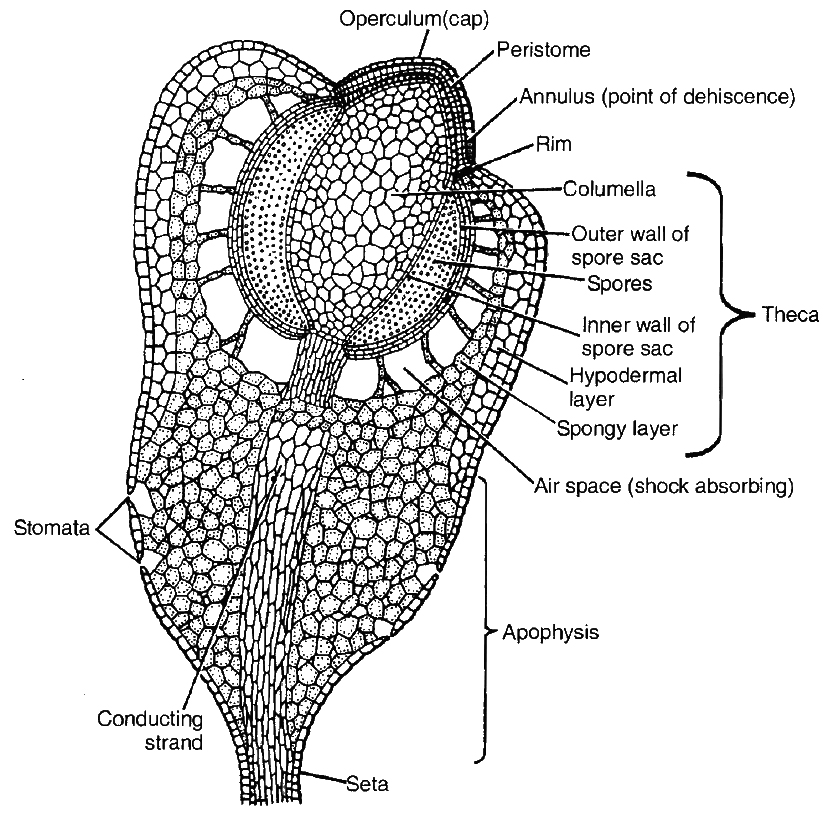

 Maria Habib
Maria Habib
